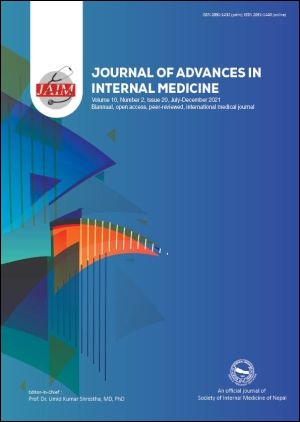Holter monitoring for assessment of possible paroxysmal atrial fibrillation as a cause in otherwise normal sinus rhythm patients with acute ischemic stroke: a hospital based study
DOI:
https://doi.org/10.3126/jaim.v10i2.42166Keywords:
Ischemic Stroke, Paroxysmal Atrial Fibrillation, Holter MonitoringAbstract
Background: Stroke/ cerebrovascular accidents are common and among the major causes of mortality and morbidity. Thromboembolism are also among the causes of ischemic strokes. Diagnosis of atrial fibrillation makes the difference in the management of ischemic strokes for long term as anticoagulation are given in these cases for prevention of further embolic events.
Methods: A prospective observational study was done from july 2019 to june 2021 for patients admitted for ischemic strokes who were otherwise found to have normal sinus rhythm. A 24 hour holter monitor was connected and analyzed for possible paroxysmal atrial fibrillation. Baseline investigations including trans-thoracic echocardiography was done. Data were analyzed and results were sought.
Results: Out of 212 patients admitted for stroke, only 116 were eligible for the study. Male female ratio was 2:1. Ninety-four percent of patients had at least one or more risk factors: Smokers (74%) followed by Hypertensives (70%), Dyslipidemics (54%) and Diabetics (20%). Twenty-two percent of patients were found to have paroxysmal atrial fibrillation. There was no gender difference between the occurrences of paroxysmal atrial fibrillation. Among the risk factors, smoking and hypertension were significantly associated with the occurrence of paroxysmal atrial fibrillation (P: 0.001 and 0.002 respectively) while other risk factors like diabetes and dyslipidemia had no significant association. There was significant association of paroxysmal atrial fibrillation with mortality (P: 0.0013).
Conclusion: Patients who are in otherwise normal sinus rhythm in electrocardiography with ischemic cerebrovascular accidents may have paroxysmal atrial fibrillation as cause of event. Smoking and hypertensive patients are significantly associated with occurrence of paroxysmal atrial fibrillation and stroke and these patients are more likely to die than the patients having normal heart rhythm. Management of these patients definitely defer in terms of possible use of anticoagulants.
Downloads
Downloads
Published
How to Cite
Issue
Section
License
Copyright (c) 2021 Navaraj Paudel, Namrata Thapa, Ramchandra Kafle, Subash Sapkota, Abhishek Maskey

This work is licensed under a Creative Commons Attribution 4.0 International License.
This license enables reusers to distribute, remix, adapt, and build upon the material in any medium or format, so long as attribution is given to the creator.




